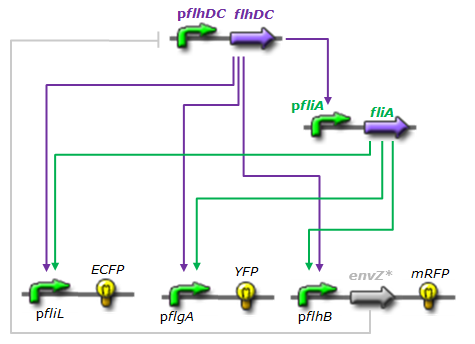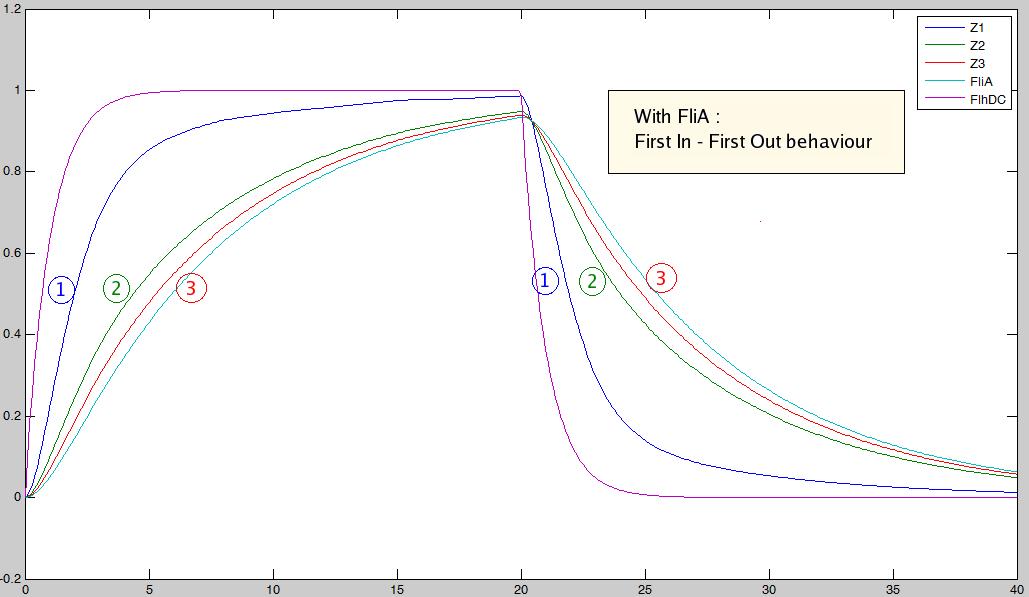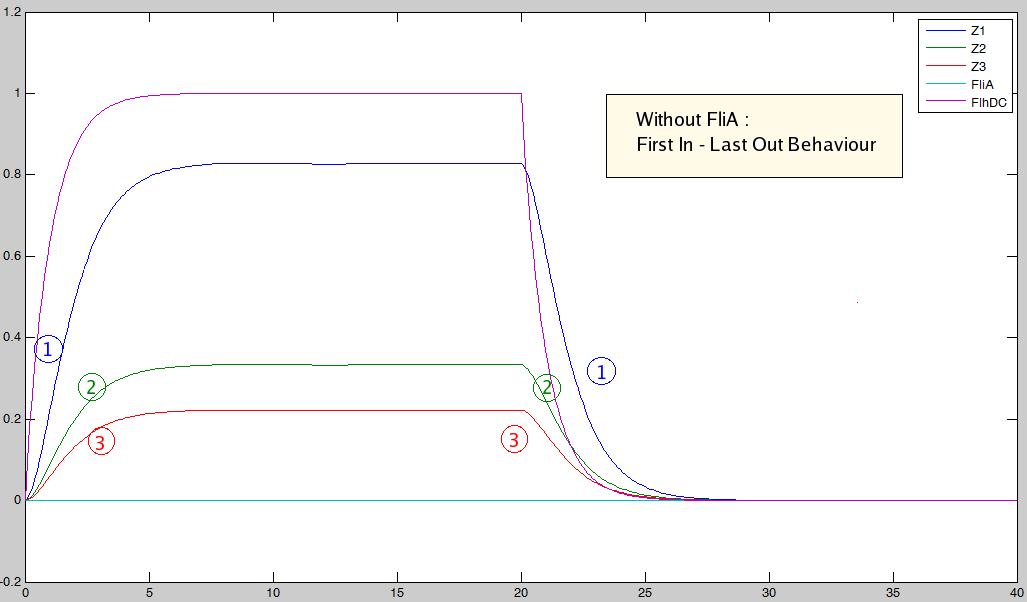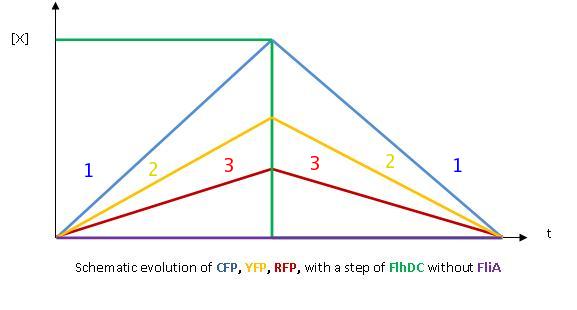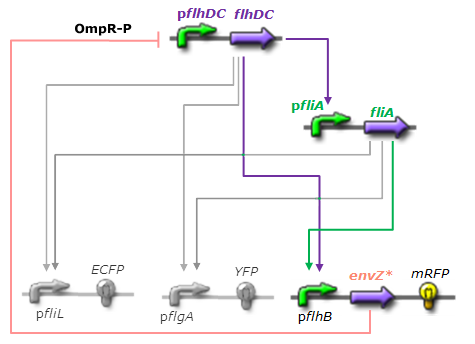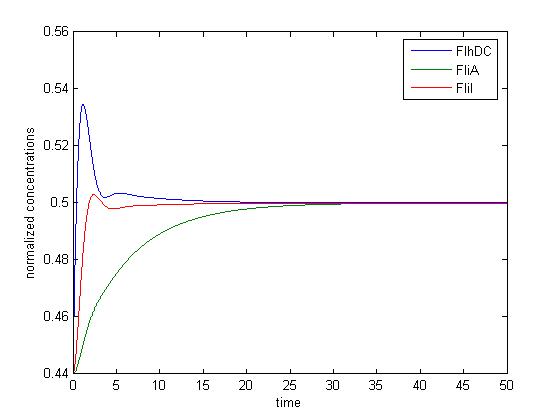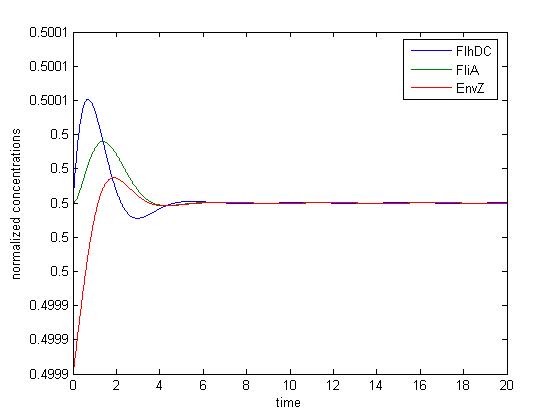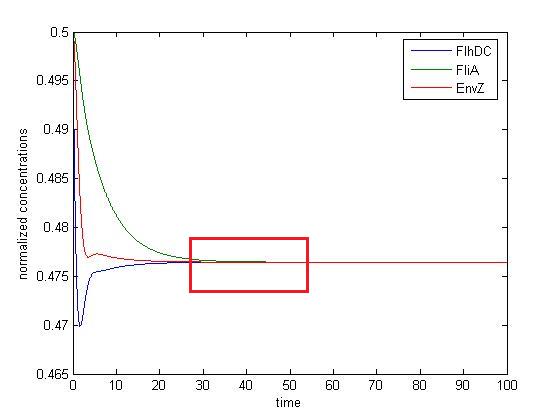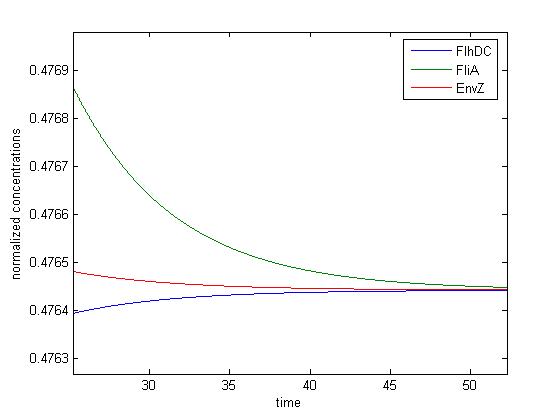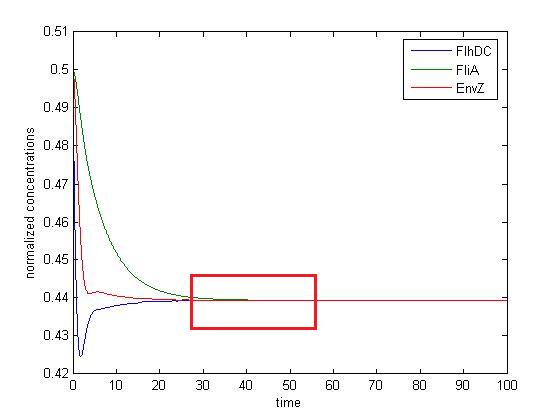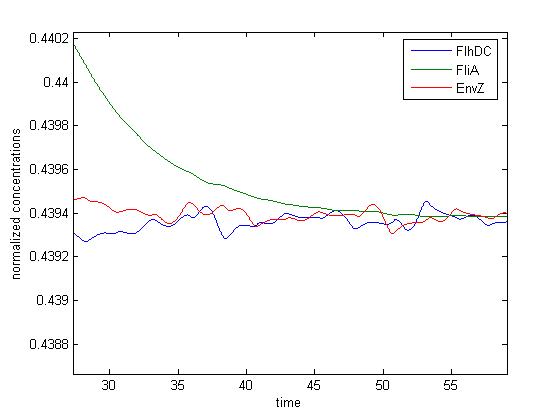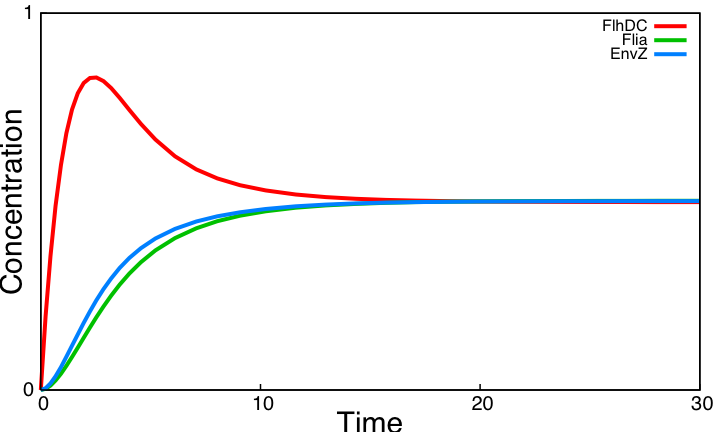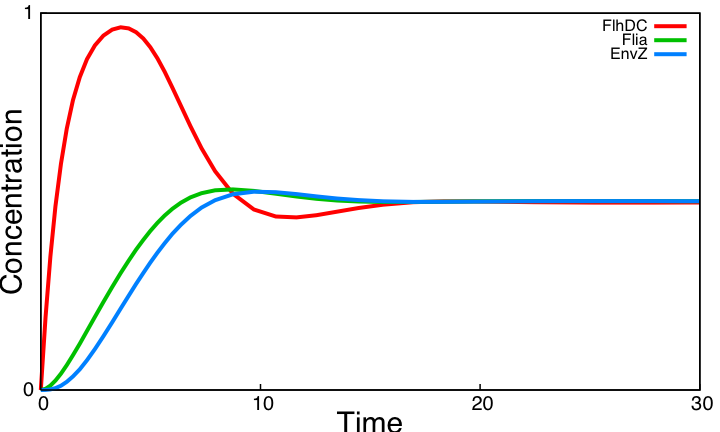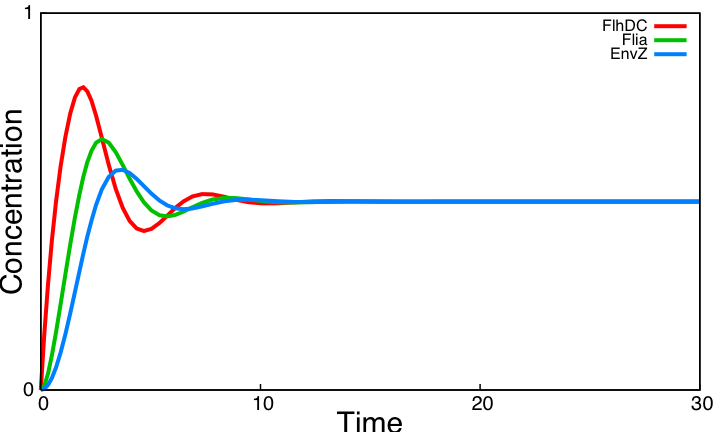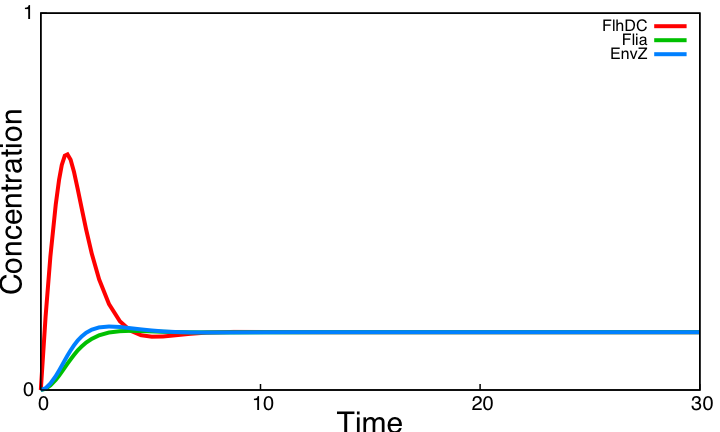Team:Paris/Analysis/Math+Sim
From 2008.igem.org
(→Navigator) |
(→Oscillations) |
||
| (13 intermediate revisions not shown) | |||
| Line 1: | Line 1: | ||
{{Paris/Menu}} | {{Paris/Menu}} | ||
| - | + | {{Paris/Header|Mathematical Analysis and Simulations}} | |
| - | + | {{Paris/Section_contents_analysis}} | |
| - | + | ||
= FIFO = | = FIFO = | ||
| Line 8: | Line 7: | ||
<br> | <br> | ||
| - | [[Image: | + | [[Image:FIFO.png|400px|left]][[Image:essai_with_fliAbis.jpg|500px|center]] |
Here is the set of equations used for the numerical simulations, with the parameters found in bibliographical studies (note that you can have an explanation on the way they have been built on the [[Team:Paris/Network_analysis_and_design/Core_system/Model_construction|Model Construction]] page): | Here is the set of equations used for the numerical simulations, with the parameters found in bibliographical studies (note that you can have an explanation on the way they have been built on the [[Team:Paris/Network_analysis_and_design/Core_system/Model_construction|Model Construction]] page): | ||
| Line 41: | Line 40: | ||
= Oscillations = | = Oscillations = | ||
* In addition to the previous FIFO system, we will add a negative feedback on FlhDC promoter to observe oscillations. Thus, we obtained the following network and the corresponding equations (notice that we decide to model in a single arrowthe process through which that EnvZ repress FlhDC): | * In addition to the previous FIFO system, we will add a negative feedback on FlhDC promoter to observe oscillations. Thus, we obtained the following network and the corresponding equations (notice that we decide to model in a single arrowthe process through which that EnvZ repress FlhDC): | ||
| - | [[Image: | + | [[Image:Reseauoscillfinal.png|400px|center]] |
<br> | <br> | ||
[[Image:eqn_flhDC.jpg|center]] | [[Image:eqn_flhDC.jpg|center]] | ||
| Line 66: | Line 65: | ||
Finally, the logical continuation of the process will be to try to improve the biological system in order to find oscillations. This will be described in the part below, as well as in the section [[Team:Paris/Network_analysis_and_design/System_improvements|System Improvements]]. | Finally, the logical continuation of the process will be to try to improve the biological system in order to find oscillations. This will be described in the part below, as well as in the section [[Team:Paris/Network_analysis_and_design/System_improvements|System Improvements]]. | ||
| - | = System analysis = | + | = System interactions analysis = |
Simulations of the core system displayed above reveal that it does not exhibit an oscillatory behavior. In this section we use the model of the core system to try to figure out the contribution of some key characteristics of the network topology on the dynamics of the system. This analysis is done by successively simulating altered forms of the system. | Simulations of the core system displayed above reveal that it does not exhibit an oscillatory behavior. In this section we use the model of the core system to try to figure out the contribution of some key characteristics of the network topology on the dynamics of the system. This analysis is done by successively simulating altered forms of the system. | ||
| Line 98: | Line 97: | ||
| style=" text-align:center;" |[[Image:Core5.png|280px|center]] | | style=" text-align:center;" |[[Image:Core5.png|280px|center]] | ||
| style=" text-align:center;" |[[Image:Orgstar.gif]] | | style=" text-align:center;" |[[Image:Orgstar.gif]] | ||
| - | | Non oscillating system. A | + | | Non oscillating system. This variant consist in decreasing the threshold value of EnvZ above which flhDC is inhibited. A lower threshold slightly improves the behavior of the system. This value of this parameter is unknown and can thus be used as control to obtain oscillations. |
|- style="background: #dddddd;" | |- style="background: #dddddd;" | ||
| style="background: #D4E2EF; text-align:center;"|[[Image:Core_system4.png|center|150px]]Combining three modifications all together. | | style="background: #D4E2EF; text-align:center;"|[[Image:Core_system4.png|center|150px]]Combining three modifications all together. | ||
| Line 107: | Line 106: | ||
| - | The core system cannot provide oscillations. Even with the alternatives examined above it can only show damped oscillations. Moreover, despite its negative effects on oscillations, activation of envZ by FlhDC | + | The core system cannot provide oscillations. Even with the alternatives examined above it can only show damped oscillations. Moreover, despite its negative effects on oscillations, activation of envZ by FlhDC should not be removed as it is required for the FIFO behavior of the system. |
| - | + | ||
| - | + | ||
| - | + | ||
| - | + | ||
| + | In the [[Team:Paris/Network_analysis_and_design/System_improvements/Description|next section]], we examine significant topology improvements of the core system that are potentially better for oscillations and that preserve FIFO required interactions. | ||
| - | |||
| - | |||
| - | + | {{Paris/Navig|Team:Paris/Analysis}} | |
Latest revision as of 03:18, 30 October 2008
|
Mathematical Analysis and Simulations
Other pages:
FIFO
Here is the set of equations used for the numerical simulations, with the parameters found in bibliographical studies (note that you can have an explanation on the way they have been built on the Model Construction page): where CFP, YFP, and RFP will be denoted below as respectively Z1,Z2 and Z3. We have implemented this system using Matlab (see the corresponding codes)
Indeed, we may see that there is a LIFO behavior rather than the FIFO we expect... For a qualitative understanding of what is going on with and without FliA : ↓ Qualitative reasoning about the FIFO ↑
Oscillations
If you want more details about the way we have built them, you can go to the model construction page. If one tries to draw simulations of this system, he will obtain this kind of results : In a nutshell : It does not work !
↓ mathematical analysis ↑
↓ Impact of integration methods ↑
System interactions analysisSimulations of the core system displayed above reveal that it does not exhibit an oscillatory behavior. In this section we use the model of the core system to try to figure out the contribution of some key characteristics of the network topology on the dynamics of the system. This analysis is done by successively simulating altered forms of the system. The following table lists the different forms of the system considered and their respective outcome :
In the next section, we examine significant topology improvements of the core system that are potentially better for oscillations and that preserve FIFO required interactions.
|
 "
"

